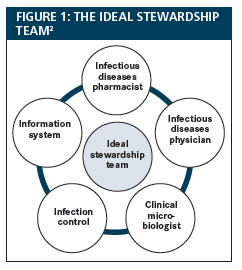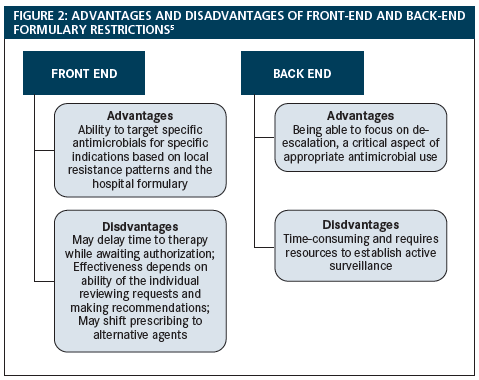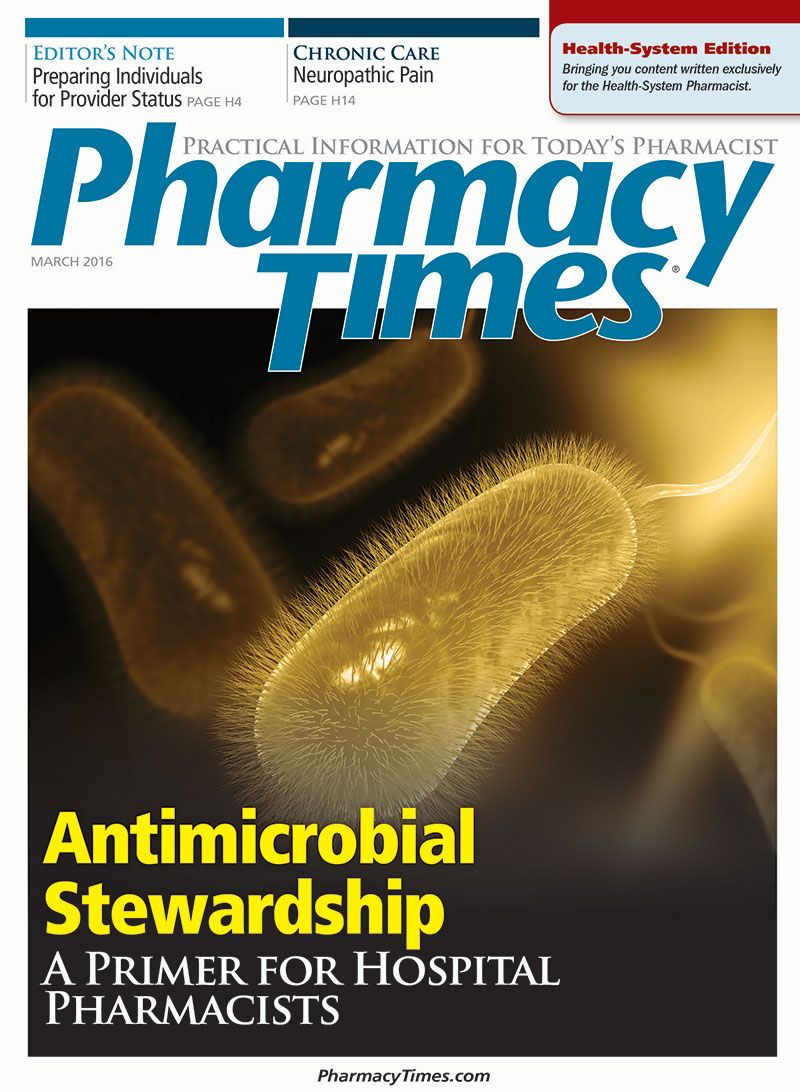Publication
Article
Pharmacy Practice in Focus: Health Systems
Antimicrobial Stewardship: A Primer for Hospital Pharmacists
The CDC has reported that 20% to 50% of all antibiotics prescribed in US acute care hospitals are either unnecessary or inappropriate, resulting in avoidable adverse effects, bacterial resistance, and an increased incidence of infection.
The Centers for Disease Control and Prevention (CDC) has reported that 20% to 50% of all antibiotics prescribed in US acute care hospitals are either unnecessary or inappropriate, resulting in avoidable adverse effects, bacterial resistance, and an increased incidence of Clostridium difficile infection.1 The evolution of multidrug resistant organisms has limited the available antimicrobial treatment choices, making the improvement of antibiotic use a public health priority.1 As a result, there has been increased interest in establishing antimicrobial stewardship programs, nationwide.
Antimicrobial stewardship is a coordinated approach that aims to improve the appropriate use of antimicrobials, thereby reducing antimicrobial resistance and improving patient outcomes through targeted interventions. Effective antimicrobial stewardship programs have substantially improved clinical outcomes, decreased use of unnecessary antimicrobials, reduced C difficile infections, and reduced drug resistance.1 Although these programs are also associated with potential annual savings in antimicrobial expenditures, such financial gains are often seen early in program development and may plateau over time.2 Comparatively, the clinical effects of these programs have lasting benefits for institutions.
NATIONAL ACTION PLAN FOR COMBATING ANTIBIOTICRESISTANT BACTERIA
In response to the antibiotic resistance crisis, the White House has published the National Action Plan for Combating Antibiotic-Resistant Bacteria.1,3
President Barak Obama issued an Executive Order on Combating Antibiotic-Resistant Bacteria in September 2014. The National Action Plan was developed as guidance for implementing the Executive Order, with goals to slow the emergence of ment of diagnostic tools to identify resistant bacteria, promote and accelerate research for new antibiotics and vaccines, and strengthen surveillance efforts.3 Importantly, the plan establishes that, by 2020, antimicrobial stewardship programs should be active in all acute care hospitals, and inappropriate antibiotic use should be reduced by 50% in outpatient settings and 20% in inpatient settings.3 To do this, the plan recommends a regulatory requirement for antimicrobial stewardship be in place by 2017.
ANTIBIOTIC STEWARDSHIP PROGRAM CORE ELEMENTS
To establish a successful antimicrobial stewardship program at an institution, the CDC recommends 7 core elements, which can be found in Table 11.
The foundation of any antibiotic stewardship program is a multidisciplinary stewardship team. Ideally, the stewardship team consists of an infectious diseases physician, an infectious diseases pharmacist, a clinical microbiologist, an infection control professional, and an information system specialist.2 Embedded within this team are the first 3 core elements for an antimicrobial stewardship program. Leadership commitment is evidenced by the support of hospital administration, such as dedicating the necessary personnel, financial resources, and information technology resources. Accountability and drug expertise can be achieved by appointing a single leader to be responsible for program outcomes and a single pharmacist leader to be responsible for improving antibiotic use. Figure 12 shows the ideal stewardship team. Table 21,4-7 provides the types of stewardship interventions.

After the stewardship “dream team” is established, the next step is to implement at least 1 intervention. Many types of interventions exist, and each has advantages and disadvantages:
- Education and Guidelines4: One intervention is to develop institution- specific guidelines that are modeled after national guidelines and take local susceptibility patterns into consideration, and to make these guidelines available to all providers. This can guide appropriate empiric antibiotic regimens and duration of treatment for common disease states (eg, instituting hospital guidelines for the treatment of communityacquired pneumonia and urinary tract infections). One advantage is the ability to adapt institution guidelines to the hospital’s antibiogram and population. However, this type of intervention requires buy-in by prescribers, and adherence to the guidelines is not required. Incorporation of guidelines and treatment pathways into computerized physician support systems can increase adherence to recommendations.
- Formulary Restrictions5: Antibiotic restriction is a commonly used strategy to control antimicrobial use and can be implemented as front-end restricted, back-end restricted, or a combination of both. Front-end restriction: With frontend restriction, certain antimicrobials are considered restricted and require preauthorization for use from an antimicrobial stewardship team member or based on a set of preauthorization criteria reviewed by a pharmacist. For example, an antibiotic such as daptomycin may require preauthorization from an infectious diseases consultant based on predefined prescribing criteria before it can be dispensed. Back-end restriction: Back-end restriction refers to review and intervention after the antimicrobial is prescribed. Typically, an antimicrobial steward reviews current antibiotic orders and provides prescribers with recommendations to continue, adjust, change, or discontinue the therapy, based on the available microbiology results and clinical features of the case. Front- and back-end restriction: Front- and back-end formulary restrictions can coexist with the use of prospective auditing, as well as intervention and feedback. Figure 25 shows the advantages and disadvantages of front- and back-end formulary restrictions.
- Intravenous (IV)-to-oral conversion4,5: Another intervention is to empower pharmacists to switch highly bioavailable antimicrobials from IV to oral formulations for clinically stable patients who are able to take oral medications. IV-to-oral conversion can reduce costs and the incidence of catheter- related infections. Table 35 lists highly bioavailable antimicrobials, which are good candidates for IV-to-oral switch programs.
- IV batching: For expensive antibiotics that come as singleuse vials, writing and establishing dose-rounding protocols can reduce waste and costs. These protocols can be made available on an institution’s intranet for into computer ordering systems to maximize adherence.
- Therapeutic substitutions: With careful consideration of the institution’s antibiogram and the necessary antimicrobials to keep on formulary, therapeutic substitutions may be made by maintaining 1 antimicrobial per class, such as a single carbapenem or fluoroquinolone, on formulary to reduce inventory and costs.
- Antibiotic “timeout” at 72 hours after antibiotic initiation6: An antibiotic timeout is a pause during interdisciplinary rounds to verify that each antimicrobial is appropriately indicated, check for updated culture and sensitivity results, and de-escalate therapy, when appropriate. An antibiotic timeout helps ensure appropriate use, dosing, and duration for every antimicrobial and allows discussion by the team.
- Antimicrobial cycling2: This strategy sets a scheduled rotation of antimicrobials to reduce resistance by changing selective pressure. For example, an intensive care unit may use piperacillin/ tazobactam as the preferential gram-negative agent of choice for one quarter and switch to cefepime for the next quarter. However, there are few studies on the effectiveness of this approach; many patients are excluded on the basis of past culture data or surveillance cultures, and antimicrobial cycling is not currently recommended by the Infectious Diseases Society of America Antimicrobial Stewardship Guidelines.

Another core element of antimicrobial stewardship is to measure the effects of the antimicrobial stewardship actions by using performance measures to track antibiotic prescribing, use, and resistance.1 Institutions can monitor this in several different ways, depending on which interventions were implemented. For example, an institution can measure rates of C difficile infection, compile and publish antibiograms on antibiotic susceptibility reports, and assess adherence to antimicrobial guidelines and interventions.
In addition to tracking, the antimicrobial steward should report the findings on antibiotic use and resistance to doctors, nurses, and other relevant staff.1 Sharing facility-specific reports on antibiotic use with providers allows direct communication on how providers can improve antibiotic prescribing and raise awareness for areas of improvement.
The last core element recommends that antimicrobial stewardship programs regularly provide education to health care providers about resistance and improving antibiotic prescribing.1 Education can be provided in various formats, such as presentations, printed flyers, or electronic messages. In addition, case presentations at grand rounds or case conferences can demonstrate examples of appropriate de-escalation of therapy.
CONCLUSION
The growing problem of antimicrobial resistance has been recognized nationally. To combat this issue, all acute care institutions should implement antimicrobial stewardship programs. Each institution may employ different interventions according to its size, antibiotic use, antimicrobial resistance patterns, and available information technology. With the implementation of successful antimicrobial stewardship programs and the support of hospital administration, we can slow the antibiotic resistance crisis at the institutional level, as well as nationally.
Kathy Tang, PharmD, is a PGY-1 pharmacy resident at the University of Maryland Medical Center in Baltimore, Maryland. Emily Heil, PharmD, BCPS-AQ ID, AAHIVP, is a clinical pharmacy specialist in infectious diseases at the University of Maryland Medical Center in Baltimore, Maryland.
References
- Get Smart for Healthcare. Centers for Disease Control and Prevention website. cdc.gov/getsmart/healthcare. Accessed December 10, 2015.
- Dellit TH, Owens RC, McGowan JE Jr, et al. Infectious Diseases Society of America and the Society for Healthcare Epidemiology of America Guidelines for Developing an Institutional Program to Enhance Antimicrobial Stewardship. Clin Infect Dis. 2007;44(2):159-177.
- National Action Plan for Combating Antibiotic-Resistant Bacteria. The White House Forum on Antibiotic Stewardship. whitehouse.gov/sites/default/files/docs/national_action_plan_for_combating_antibotic-resistant_bacteria.pdf. Accessed December 10, 2015.
- MacDougall C, Polk RE. Antimicrobial stewardship programs in health care systems. Clin Microbiol Rev. 2005;18(4):638-656.
- Doron S, Davidson LE. Antimicrobial stewardship. Mayo Clin Proc. 2011;86(11):1113-1123. doi: 10.4065/mcp.2011.0358.
- Flanders SA, Saint S. Why does antimicrobial overuse in hospitalized patients persist? JAMA Intern Med. 2014;174(5):661-662.







